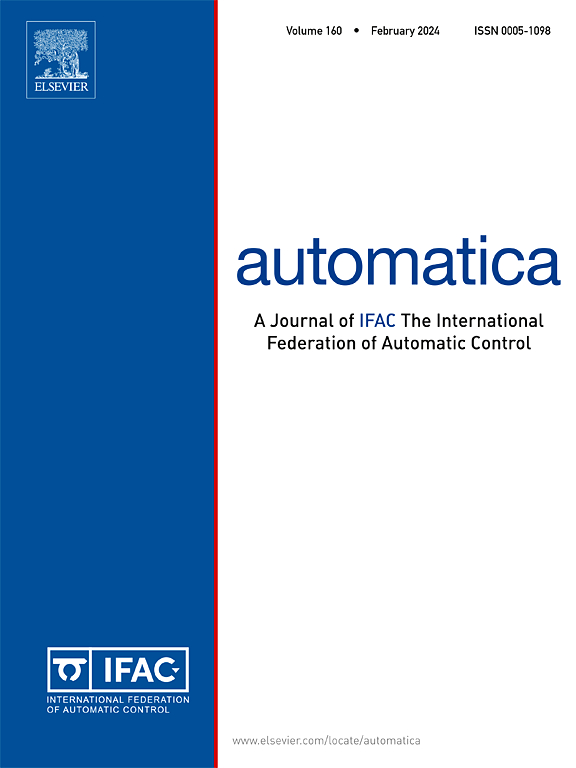Closed-form adaptive tracking control of heat equations aided by Fourier regularization and bi-orthogonal series
IF 4.8
2区 计算机科学
Q1 AUTOMATION & CONTROL SYSTEMS
引用次数: 0
Abstract
This article proposes a closed-form adaptive tracking control approach for linear heat equations with unknown parameters to achieve full temperature profile tracking by leveraging Fourier regularization and bi-orthogonal series. A state predictor which copies the plant with state partial derivatives and unknown parameters replaced by their estimates is built and an adaptive law is designed to estimate the unknown parameters. The state predictor is decomposed into two subsystems for tracking control synthesis: the first subsystem involves terms from the original heat equation, while the second subsystem is simpler and can be reformulated as a standard heat equation. Specifically, the first subsystem is regarded as an unforced PDE whose terminal states always follow the desired temperature profile such that its initial condition can be calculated by solving the backward heat equation at every time step. To address the blow-up issue in backward calculation, a Fourier regularization scheme is explored to cut off the higher-order Fourier modes and an appropriate tradeoff between approximation accuracy and robustness is achieved. Given the solutions from the first subsystem, the initial condition for the second subsystem can be subsequently calculated. We propose a numerical algorithm to calculate a set of bi-orthogonal series online and employ them to compute the boundary control function that drives the second subsystem to zero at every time step. Combining these two subsystems, it guarantees that the overall system follows the desired temperature profile. We demonstrate that the proposed closed-form adaptive tracking control algorithm achieves full temperature profile tracking with around 5% error averaged over the entire space, that is, norm over time.
傅立叶正则化和双正交序列辅助热方程的闭式自适应跟踪控制
本文提出了一种利用傅立叶正则化和双正交级数实现未知参数线性热方程全温度分布跟踪的封闭式自适应跟踪控制方法。构造了一个状态预测器,它复制被控对象的状态偏导数和未知参数,并设计了一个自适应律来估计未知参数。将状态预测器分解为两个子系统进行跟踪控制综合:第一个子系统涉及原始热方程的项,而第二个子系统更简单,可以重新表述为标准热方程。具体地说,第一个子系统被认为是一个非强制PDE,它的终端状态总是遵循期望的温度分布,因此它的初始条件可以通过在每个时间步长解逆向热方程来计算。为了解决反向计算中的爆破问题,探索了一种傅里叶正则化方案来切断高阶傅里叶模式,并在近似精度和鲁棒性之间实现了适当的权衡。给出了第一个子系统的解,就可以计算出第二个子系统的初始条件。我们提出了一种在线计算双正交级数的数值算法,并利用它们来计算使第二子系统在每个时间步长都归零的边界控制函数。结合这两个子系统,它保证了整个系统遵循所需的温度曲线。我们证明了所提出的封闭式自适应跟踪控制算法实现了整个温度曲线跟踪,整个空间的平均误差约为5%,即L2范数随时间的变化。
本文章由计算机程序翻译,如有差异,请以英文原文为准。
求助全文
约1分钟内获得全文
求助全文
来源期刊

Automatica
工程技术-工程:电子与电气
CiteScore
10.70
自引率
7.80%
发文量
617
审稿时长
5 months
期刊介绍:
Automatica is a leading archival publication in the field of systems and control. The field encompasses today a broad set of areas and topics, and is thriving not only within itself but also in terms of its impact on other fields, such as communications, computers, biology, energy and economics. Since its inception in 1963, Automatica has kept abreast with the evolution of the field over the years, and has emerged as a leading publication driving the trends in the field.
After being founded in 1963, Automatica became a journal of the International Federation of Automatic Control (IFAC) in 1969. It features a characteristic blend of theoretical and applied papers of archival, lasting value, reporting cutting edge research results by authors across the globe. It features articles in distinct categories, including regular, brief and survey papers, technical communiqués, correspondence items, as well as reviews on published books of interest to the readership. It occasionally publishes special issues on emerging new topics or established mature topics of interest to a broad audience.
Automatica solicits original high-quality contributions in all the categories listed above, and in all areas of systems and control interpreted in a broad sense and evolving constantly. They may be submitted directly to a subject editor or to the Editor-in-Chief if not sure about the subject area. Editorial procedures in place assure careful, fair, and prompt handling of all submitted articles. Accepted papers appear in the journal in the shortest time feasible given production time constraints.
 求助内容:
求助内容: 应助结果提醒方式:
应助结果提醒方式:


